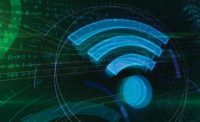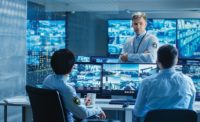How Video Analytics Help Security Drive Awareness and Insight
In diverse industries, video analytics help security to get a clearer view.


Video analytics doesn’t just enhance the security mission, acting as a force multiplier and driving new levels of awareness and insight. They also boost the position of the security professional within the overall enterprise, enabling security to leverage its investment in video as a means to drive new levels of efficiency across all levels of the operation.

Consider all the luminous dials in a hydroelectric plant or an oil refinery: Constant reminders that pressure and temperature are key determinants of safety. Security personnel can make use of analytics to monitor this vast array of analog sensors more effectively and in real time,” says Forrester Senior Analyst Nick Barber.
Photo courtesy of Nick Barber

“Left objects or ‘loitering’ analytics will aid hospital security teams to identify either suspicious packages or behaviors, particularly if these alerts are generated in areas that should not have significant amounts of foot-traffic,” says Danielle VanZandt, industry analyst for security, aerospace, defense and security at Frost & Sullivan.
Photo courtesy of Danielle VanZandt




As a rule, there is a lot that video analytics can do to bolster security – whether that’s motion detection for perimeter security; facial recognition for access control; or artificial intelligence (AI) for object classification, to name a few of the possibilities.
As we consider the promise of video analytics in seven key sectors, a common theme emerges. Analytics don’t just enhance the security mission, acting as a force multiplier and driving new levels of awareness and insight. They also boost the position of the security professional, enabling security to leverage its investment in video as a means to drive new levels of efficiency across all levels of the operation.
K-12 Schools
In a K-12 school, where a security officer may need to watch over a large and complex facility, analytics and AI can expand that guard’s reach. “There is the security component from something simple: Was a child left on the playground when everyone returned from recess?” says Forrester Senior Analyst Nick Barber. “AI could be trained to tell the difference between a child and an adult, so that it isn’t falsely triggered if there is a teacher on the playground versus a student.”
“Or, is there an active shooter on campus and should 911 be contacted?” Barber says. AI, as applied to video, could be trained to recognize what a gun looks or sounds like and could automatically alert authorities, while simultaneously relaying the related video. Analytics could support simpler tasks as well, such as taking attendance as students enter the school or classroom.
Universities
The security challenge for universities and college campuses rests with sheer acreage. Universities may have a large security footprint, with their own police departments supported by cameras and a monitoring center. But they also have a lot of ground to cover. Analytics can provide a force multiplier.
Facial recognition, for instance, can offer a ‘be on the lookout’ mechanism to help security identify persons of interest. “If there’s a stalker, the analytics can pick up on those individuals,” says Scott Vogel, CEO of Incyte Security, a data analytics consultancy. Geofencing and other analytic tools can likewise help secure a sprawling perimeter. “You may have people hopping the fence at night to avoid the security gate, and analytics can provide a virtual barrier.”
Healthcare
In the healthcare environment, video is of greatest use in helping to secure entry and exit points, whether that is aimed at keeping unwanted individuals out of an emergency-care situation, or at keeping dementia patients in and on-premise at a senior care facility. “Analytics solutions can alert operators when people either enter or exit secure areas without proper identification procedures, such as swiping a badge, or they can utilize some facial recognition features to be sure that the person on camera who has earned entrance to a secure area is the person they are claiming to be,” says Danielle VanZandt, industry analyst for security, aerospace, defense and security at Frost & Sullivan.
Analytics can also be used to identify potential threats that might otherwise be overlooked by security personnel. Left objects or ‘loitering’ analytics will aid hospital security teams to identify either suspicious packages or behaviors, particularly if these alerts are generated in areas that should not have significant amounts of foot-traffic.
Cannabis
Video analytics can help cannabis growers to identify possible threats to the safety of their crop, says Ryan Douglas, founder of consulting firm Ryan Douglas Cultivation LLC. “High-tech greenhouses install mobile cameras that constantly run along tracks mounted to the ceiling. Analyzing this video can help with the early identification of pest or disease outbreaks, nutritional deficiencies and undesirable growth patterns before they negatively affect a crop,” Douglas says. It’s a way for security to leverage its video investment in support of enhanced operational efficiency.
Security could also utilize analytics to help ensure cannabis retailers comply with regulations, if, for instance, the system was programmed to monitor quantities of product changing hands at the point of sale. “It could ensure that during the purchase transaction, buyers don’t exceed the amount of product that they are legally allowed to purchase,” Barber says.
At grow sites, analytics can also be applied to remote video surveillance systems to help secure the perimeter. Motion-detection capabilities and geofencing can likewise be leveraged to extend the eyes of the security force over the growing and production operations.
Property Management
For security on a commercial property, video alone can’t cover all the bases. Property management requires a combination of broad vision and deep insights. Beyond mere images, analytics can deliver the intelligence to help security professionals make best use of their time and cover ground more effectively.
“You might have teenagers climbing on the roof of the building. Beyond the general liability problem, they are damaging the roof,” Vogel says. “With analytics, you can identify the places where people go up on that roof and notify security. Within seconds you get notification and hopefully can deter that incident.”
Analytics can detect patterns of behavior, noting when a parking lot is filling up. This helps to ensure adequate security coverage when and where it is needed. Video analytic tools can help security to deter theft from commercial properties, by highlighting common traffic-flow patterns and sending out a notification to security officers when those patterns are disrupted. This helps security to see when products may potentially be walking out the back door and, with the help of automated notifications, to respond in real time.
Critical Infrastructure
Consider all the luminous dials in a hydroelectric plant or an oil refinery: Constant reminders that pressure and temperature are key determinants of safety. Security personnel can use analytics to monitor a vast array of analog sensors more effectively and in real time. Point a camera at an analog gauge, program the analytics to watch for threshold levels, “and an alert can get triggered if the pressure rises above a certain point as seen on the dial,” Barber says.
Video can also be used to understand how specific elements of the facility are operating and can signal when key components need replacement. Security thus pushes critical infrastructure closer to an IoT-enabled enterprise, Barber says.
Security personnel also are charged with tracking workers, vendors and others who at critical infrastructure facilities. Video analytics capabilities, when paired with surveillance systems that provide facial recognition, will help critical infrastructure to improve access control, maintain security logs for entry and exits in specialized areas and better manage visitors or contractors, VanZandt says.
Manufacturing
Access control is a key issue in manufacturing, with security tasked to ensure that only the right people can get to certain places, especially sensitive production areas and inventory stores.
Analytics can help here by making it easier for security to maintain logs of entries and exits in specialized areas. Paired with facial recognition, video systems can enable security to better manage contractors and visitors.
Analytics can help security to detect anomalies that might be indicative of an emerging situation. “Motion or object detection functions that can detect activity in a specified area, or can pinpoint suspicious objects in an area, will also be of interest to industrial customers,” VanZandt says. Such capabilities might help security to ensure that nothing suspicious or potentially dangerous can be left in their facilities, and to be on guard against activities that could potentially affect operations or cause potential events within a facility.
Manufacturers also can leverage the predictive capability of video analytics to deliver forecasts. Analysis of thermal imaging, for example, can help to schedule downtime for maintenance.
It’s just that kind of value-add that makes video analytics an attractive proposition across such a wide range of industries. AI, facial recognition, geofencing and more can help to elevate security, making the protective force a key player in improving and enhancing operations.
Looking for a reprint of this article?
From high-res PDFs to custom plaques, order your copy today!









